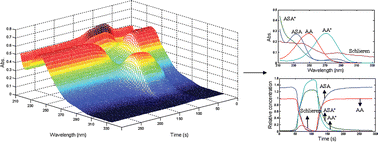Multivariate curve resolution using alternating least squares (MCR-ALS) was used to quantify ascorbic (AA) and acetylsalicylic (ASA) acids in four pharmaceutical samples using a flow injection analysis (FIA) system with pH gradient and a diode array (DAD) spectrometer as a detector. Four different pharmaceutical drugs were analyzed, giving a data array of dimensions 51 × 291 × 61, corresponding respectively to number of samples, FIA times and spectral wavelengths. MCR-ALS was applied to these large data sets using different constraints to have optimal resolution and optimal quantitative estimations of the two analytes (AA and ASA). Since both analytes give an acid–basic pair of species contributing to the UV recorded signal, at least four components sholuld be proposed to model AA and ASA in synthetic mixture samples. Moreover, one additional component was needed to resolve accurately the Schlieren effect and another additional component was also needed to model the presence of possible interferences (like caffeine) in the commercial drugs tablets, giving therefore a total number of 6 independent components needed. The best quantification relative errors were around 2% compared to the reference values obtained by HPLC and by the oxidation–reduction titrimetric method, for ASA and AA respectively. In this work, the application of MCR-ALS allowed for the first time the full resolution of the FIA diffusion profile due to the Schlieren effect as an independent signal contribution, suggesting that the proposed MCR-ALS method allows for its accurate correction in FIA-DAD systems.

You have access to this article
 Please wait while we load your content...
Something went wrong. Try again?
Please wait while we load your content...
Something went wrong. Try again?


 Please wait while we load your content...
Please wait while we load your content...